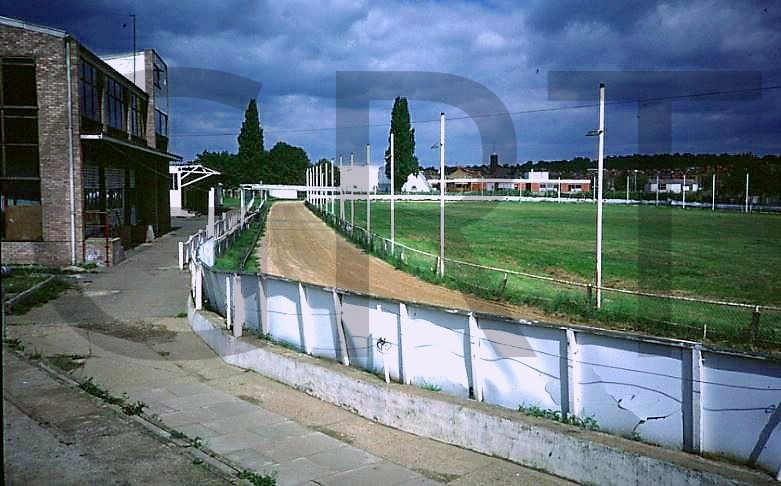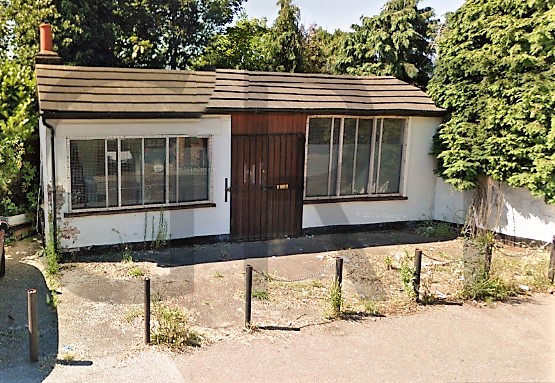The Suffolk Stadium, London Road, Ipswich, Suffolk.
POSTCODE———————————-IP1 2EJ
LOCATED————————————About three quarters of a mile west of Ipswich town centre, along London Road.
ORIGINAL SITE—————————–Allotment gardens and land liable to flooding.
DATE CONSTRUCTED——————–1935
DATE VENUE OPENED——————-September 1935.
Meaning other sports may have taken place prior to the arrival of Greyhound Racing.
FIRST MEETING—————————–September 11th 1935. A earlier track opened on the same site around 1929.
Greyhound Racing only.
LICENSED OR INDEPENDENT———-Independent until switching to NGRC during 1974.
All venues covered would have to be licensed with the government, licensed suggested in this section would refer to tracks operating under NGRC Rules.
INSIDE OR OUTSIDE HARE TYPE——Outside McKee then later The outside Sumner type.
Please note that the Electric Hare suggested is only a guidance, and would have been in operation for a certain amount of time at this venue. Although it is not necessarily guaranteed that it was operational all the time, as other types of lure may have been used and updated as time progressed.
DISTANCES———————————–258, 440, 628 and 810 metres.
Please note that most racing venues distances had become varied throughout the years, the ones given above were at once point set and offers only a guidance to the track size.
CIRCUMFERENCE—————————375 metres.
Please note that alterations at most racing venues throughout its existence would see that the circumference of the track would vary, the one shown above offers only a guidance to the track size.
BIG RACE NAMES—————————Suffolk Derby and Suffolk St Leger.
STADIUM SHARED WITH——————Nothing known of.
LAST MEETING——————————-February 17th 1988.
Greyhound Racing only.
STADIUM CLOSURE DATE—————-February 1988.
Meaning other sports may have taken place after Greyhound Racing had ceased.
STADIUM DEMOLITION——————-Late 1980’s.
BUILT ON SITE——————————-The Suffolk Retail Park constructed during 1991 with Halfords, The Range and Argos locating its once position.
In some cases, structure’s that originally covered the venue after the stadium had been demolished, may have been themselves demolished too, so the one described is more likely to be the one which now presently covers the site.
EVIDENCE LEFT TODAY——————-There is a small converted outbuilding that is found at the junction of London Road and The Retail Park entrance, which shows up on old maps and could have been once an old turnstile block.
FURTHER COMMENTS——————–None












Another of the East Anglian greyhound tracks that had spells operating as both NGRC and independent, was the London Road Stadium in Ipswich. The venue was purposely built as a Greyhound Racing venue, and in some cases may have been mistaken with the present Foxhall Stadium, a motor sports venue situated on the outskirts of the town.
Sometimes known as the Suffolk Stadium, the venue began life as a flapping track even as far back as 1929, when first events for dog racing competed on marshland along the side of a cluster of garden allotments. The site was also vulnerable to flooding, mainly due to its close proximity to the River Gipping.
Yet it was during 1935 that Ipswich became more recognised as a Greyhound Racing stadium, with its new owners investing heavily, on new buildings, improved drainage and the laying of a new grass 405-yard circumference circuit, along with the installation of a new electric trackless hare system.
Ipswich’s first meeting came on the 11th of September 1935, on an evening that attracted 4,000 patrons, who witnessed a greyhound called Comas win the first of a seven-race card, which included distances of 270 and 475 yards. The outbreak of the Second World War had little effect on events, although meetings were staged during daylight hours and coincided with the newly introduced war regulations.
By the 1950’s races consisted of five greyhounds challenging over distances of 295 and 500 yards. By the 1960’s, six dog racing became the norm once again, although distances did increase slightly to 300 and 500 yards, with the hounds now chasing an outside McKee type hare.
It was during 1960 that The Suffolk Greyhound Derby was staged for the first time, and no doubt became Ipswich’s most prestigious event, an event which was run over the 500-yard trip, and would arrive a few years prior to another classic, The Suffolk St Leger. But a more significant change came during the 1970’s, when the track accepted the invitation to switch to operating as a permit track under NGRC rules, with its first meeting coming on the 2nd of February 1974.
The track distances switched to metric, with the track being calibrated at a 375-metre circumference, which offered distances of 258, 440, 628 & 810 metres. By the 1980’s more investment had seen the grass circuit being replaced with silicon sand type, and also the outside Sumner hare replacing the earlier McKee type hare system. By 1988 the track was operating successfully, but what followed came totally out of the blue, when the council informed the stadium owners that the site had been sold and was required for redevelopment, insisting that all events at the premises to cease immediately.
Unknown to the public at the time, Ipswich staged its final meeting on the 17th of February 1988, with a greyhound called Ventry Joe winning the final event. It wasn’t until the following day that the public were informed that no more meetings would take place.
Today, the site is covered by The Suffolk Retail Park, which lies just off the Ring Road, three quarters of a mile west of Ipswich town centre. The Retail Park was constructed during 1991 with Halfords, The Range and Argos locating its once position. But what could remain as a reminder to the stadium, is a small outbuilding which may have been converted out of the old turnstile block (pictured), which is situated on the corner of London Road and the entrance road to the retail park.
Memorabilia for this track is required for this page, if you can help please contact me.

Recent Comments